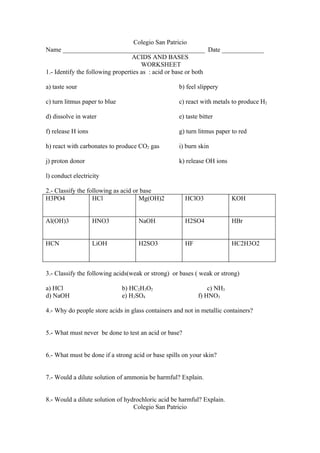Quiz Acids And Bases 5
- 1. Colegio San Patricio Name ____________________________________________ Date _____________ ACIDS AND BASES WORKSHEET 1.- Identify the following properties as : acid or base or both a) taste sour b) feel slippery c) turn litmus paper to blue c) react with metals to produce H2 d) dissolve in water e) taste bitter f) release H ions g) turn litmus paper to red h) react with carbonates to produce CO2 gas i) burn skin j) proton donor k) release OH ions l) conduct electricity 2.- Classify the following as acid or base H3PO4 HCl Mg(OH)2 HClO3 KOH Al(OH)3 HNO3 NaOH H2SO4 HBr HCN LiOH H2SO3 HF HC2H3O2 3.- Classify the following acids(weak or strong) or bases ( weak or strong) a) HCl b) HC2H3O2 c) NH3 d) NaOH e) H2SO4 f) HNO3 4.- Why do people store acids in glass containers and not in metallic containers? 5.- What must never be done to test an acid or base? 6.- What must be done if a strong acid or base spills on your skin? 7.- Would a dilute solution of ammonia be harmful? Explain. 8.- Would a dilute solution of hydrochloric acid be harmful? Explain. Colegio San Patricio
- 2. Name ____________________________________________ Date _____________ MEASURING ACIDITY 1.- What does a substance’s pH tell you? 2.- Draw the pH scale and label the acid , neutral and base areas 3.- Classify the following substances as : Very acidic, moderately acidic, slightly acidic, neutral ……. a) vinegar pH = 2 b) blood pH = 7.4 c) milk pH = 6.5 d) drain cleaner pH = 12 e) sea water pH = 8.5 e) soap pH = 9 4.- What methods are used to measure pH? 5.- Fill in with the symbols > , < or = a) For acidic solutions, the [H] is ________ than 1x10 -7 b) For basic solutions, the [H] is _________ than 1 x 10 -7 c) For neutral solutions, the [H] is _________ to 1 x 10 -7 d) For neutral solution, the [H] ______ [OH] e) For acidic solutions, the [H] ______[OH] f) For basic solutions, the [H] _______[OH] 6.- Why is universal indicator (pH paper) a better indicator to use than litmus paper? 7.- What is a disadvantage of using indicators to measure pH? 8.- What color would HCl turn red cabbage juice? _________ And NaOH? _____________ 9.- If a solution turns litmus paper to red it would be an acid or base? _________ 10.- If a solutions turns red cabbage juice to yellow, it would be an acid or base? _____ 11.- Classify the following substances as acidic, basic or neutral a) windex pH = 10 b) aspirin pH = 3 c) bleach pH = 13 d) shampoo pH = 6 e) lemon juice pH = 2 f) egg pH = 8

![Name ____________________________________________ Date _____________
MEASURING ACIDITY
1.- What does a substance’s pH tell you?
2.- Draw the pH scale and label the acid , neutral and base areas
3.- Classify the following substances as : Very acidic, moderately acidic, slightly
acidic, neutral …….
a) vinegar pH = 2 b) blood pH = 7.4
c) milk pH = 6.5 d) drain cleaner pH = 12
e) sea water pH = 8.5 e) soap pH = 9
4.- What methods are used to measure pH?
5.- Fill in with the symbols > , < or =
a) For acidic solutions, the [H] is ________ than 1x10 -7
b) For basic solutions, the [H] is _________ than 1 x 10 -7
c) For neutral solutions, the [H] is _________ to 1 x 10 -7
d) For neutral solution, the [H] ______ [OH]
e) For acidic solutions, the [H] ______[OH]
f) For basic solutions, the [H] _______[OH]
6.- Why is universal indicator (pH paper) a better indicator to use than litmus paper?
7.- What is a disadvantage of using indicators to measure pH?
8.- What color would HCl turn red cabbage juice? _________
And NaOH? _____________
9.- If a solution turns litmus paper to red it would be an acid or base? _________
10.- If a solutions turns red cabbage juice to yellow, it would be an acid or base? _____
11.- Classify the following substances as acidic, basic or neutral
a) windex pH = 10 b) aspirin pH = 3 c) bleach pH = 13
d) shampoo pH = 6 e) lemon juice pH = 2 f) egg pH = 8](https://image.slidesharecdn.com/quizacidsandbases-5-100324200729-phpapp02/85/Quiz-Acids-And-Bases-5-2-320.jpg)